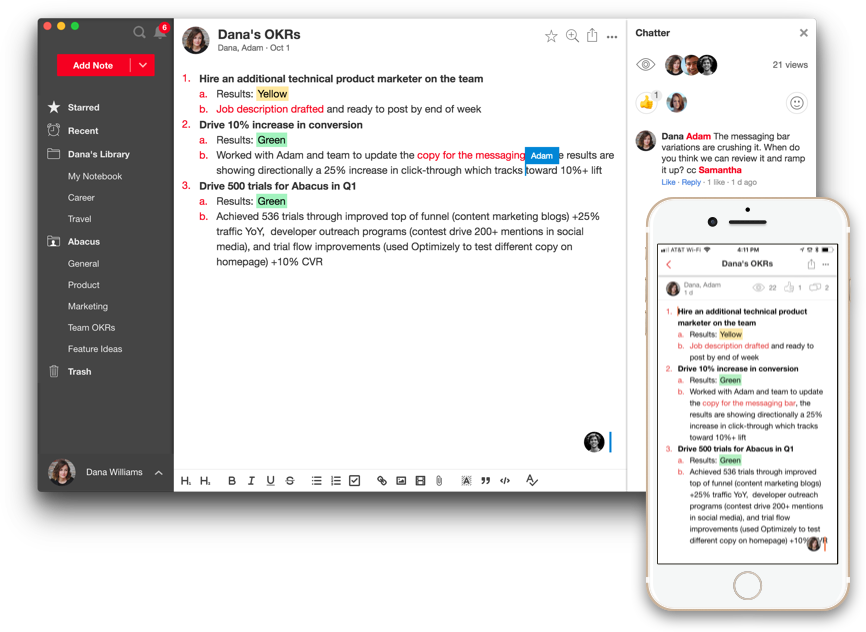Effective Meeting Agendas with Examples

When meetings veer off-track, participants arrive unprepared, and topics are irrelevant — these problems often arise due to poor agenda design.
Agendas are important because an effective one increases team productivity
An effective agenda increases the productivity of the overall meeting because it establishes expectations on what needs to occur before, during, and after a meeting. It helps get everyone on the same page on the most important topics and enables the team to quickly address key issues.
What should be included in the agenda?
As Stephen Covey writes in his book Seven Habits of Highly Effective People, “Begin with the end in mind." Agendas are lists of items that participants hope to accomplish at a meeting.
Agendas most often include:
- Informational items - sharing out updates regarding a topic for the group. For example, a manager may provide an update on the year-end planning process.
- Action items - items that you expect the group will want to review during the meeting. For example, performance against a specific time period or trajectory on a product launch.
- Discussion topics - items that you want the group to provide feedback on. For example, collecting input on an upcoming commute policy change and questions that the team has about it.
In addition to this, they'll often include specific details on how the meeting will be run. For example, agenda topics will often specify who will be presenting and for how long in order to establish expectations on who will be responsible for preparing the content and how much time they will have to present it.
Depending on the meeting, agendas can be distributed well in advance of a meeting or shared at the start of the meeting. It establishes the goal of the meeting and ensures everyone is on the same page on what you’d like to accomplish in that timeframe.
Agendas can be very short or very long
How formal should your agenda be? Often, people don’t feel like they have the time to prepare for a meeting much less write a full formal meeting agenda. When the stakes are high or the situation is very formal, it may make sense to include a formal pre-distributed agenda as well as capture meeting minutes. However, the pragmatic approach is to make agendas as simple as possible to meet the task at hand.
Informal Agenda Example
1) Intro (10 minutes - everyone)
2) Review quarter-to-date sales metrics (10 minutes)*
3) Discuss and approve proposal for next quarter’s sales goals (5 minutes)*
4) Review upcoming marketing campaign plan (15 minutes)
*See attached documents for quarterly actual and forecasted metrics.
Formal Agenda Example
1. Standing items - items that are always on the agenda of a regular meeting
- Take attendance
- Approve prior meeting’s minutes
- Team status updates
- Etc.
2. Last Meeting’s Business - discuss topics that were not completed in a previous meeting or action items that are due
- Stephanie - sales quota update (10 minutes)
- David - VP Sales hiring pipeline (5 minutes)
3. New Business - new topics for this week’s meeting
- Sam - Discuss facilities move (20 minutes)
- Randy - Employee engagement survey results (30 minutes)
4. Housekeeping - standing items at the conclusion of the meeting
- Clyde - Announcements
- Review of action items
- Date of the next meeting
- Etc.
Notejoy is a more effective way to manage your meetings
Running effective and productive meetings is more than just establishing a great template - it’s about managing the communication of information around the meeting. Is everyone on the same page about what the meeting’s topics and goals are? Have decisions been shared with everyone who needs to know? If you missed the meeting, how can you catch up on the details? Ensuring that the right people have access to information both in the meeting room and after is vital to operating a successful organization.
Notejoy is an effective solution for teams that want to manage their meeting agendas and notes to get and stay on the same page. It fundamentally changes the way that work is done.

Managing meetings in Notejoy is different for three reasons:
Real-Time Collaboration - As a cloud-based solution, Notejoy allows you to share your meeting agenda in advance with internal and external collaborators. These collaborators can view, discuss, and comment on meeting agendas as well as view the latest version.
Always in Sync - Rather than managing different versions of agendas or multiple threads of conversation, Notejoy allows the entire team to always see agendas including changes and discussions at the same time.
Improved Search and Visibility - With meeting notes and discussion comments documented directly in the agenda, teams can keep details in context and maintain one system of record for everything that happened. Manage who has access to what information, and enable team members old and new to search across past and current meeting content.
Get started free with Notejoy